EVERYONE HAS HAD THE EXPERIENCE OF STARING AT THE BACK OF A MACHINE, DEVICE, OR GADGET, SCRATCHING THEIR HEAD, GAZING IN BEWILDERMENT AT SOME UNFAMILIAR CABLE PORT.

The fact is, way too many types of cables are out there, and new ones seem to appear suddenly every few weeks. But don't worry: PCWorld has your back.
In this massive guide to the bizarre world of plugs and cables, we'll explain nearly every modern connector for computers, TVs, and audio equipment, including which ones to use when you have choices, and which ones you can easily adapt to fit others.
Even if you can find your way around your cables, you might need a refresher for new plug standards, so keep this guide handy as an ongoing reference--we'll update it as new plugs, ports, cables, and cords hit the market.
DISPLAY CABLE
Can't tell the difference between DVI and DisplayPort? Having a hard time figuring out what kind of connector your old Apple display uses? Read on for all you ever needed to know about computer monitor cables.
VGA (AKA D-SUB 15)
 Use it for: Connecting PCs, monitors, HDTVs, and video projectors
Use it for: Connecting PCs, monitors, HDTVs, and video projectors
It's similar in performance and use to: Component VGA
It adapts to: Mini-VGA, RGB Component
Add more ports by: Installing a new graphics card; connecting a splitter
The still-in-use analog classic, a VGA connector carries an RGB signal. You can often find one on PCs and HDTVs; laptops sometimes use the Mini-VGA version. Because the analog design can pick up interference, you're better off choosing a digital cable if your device supports it.
ADC (AKA APPLE DISPLAY CONNECTOR)
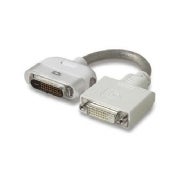 Use it for: Video and USB hub on older Macs
Use it for: Video and USB hub on older Macs
It's similar in performance and use to: DVI plus USB
It adapts to: DVI
Add more ports by: Upgrading your Mac's graphics card
Apple has phased out this proprietary display plug, but you might see it on an older monitor or Mac. Look for the rounded shape of the rectangular connector to help in identification. The cable carries power, USB, and video. You can adapt a DVI signal for an ADC monitor, but the converter boxes can be pricey; an ADC signal from a Mac is more easily converted to DVI for a standard display.
DVI (AKA DIGITAL VISUAL INTERFACE)
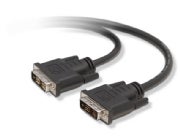
Use it for: Connecting TVs and computer displays to PCs and other devices
If you have a choice, select it instead of: VGA, component video
It's similar in performance and use to: HDMI
It adapts to: HDMI, VGA, Mini-DVI, Micro-DVI
Add more ports by: Connecting a switchbox; upgrading your graphics board
DVI comes in a few versions, having evolved as needs have grown. DVI-I (integrated) supplies an analog and digital signal, which means that you can connect an old VGA monitor to it with a simple adapter. DVI-D (digital) carries only the digital signal. Both types also offer single-link and dual-link versions; single-link has fewer pins and can't support the massive resolutions of dual-link, but you can connect a single-link monitor to a dual-link port. HDCP, the copy-protection technology used for Blu-ray and other HD sources, works with the digital signal in DVI.
MINI-DVI
![]() Use it for: Connecting small devices to DVI displays
Use it for: Connecting small devices to DVI displays
It's similar in performance and use to:DVI, HDMI
It adapts to: DVI, HDMI, Micro-DVI
Add more ports by: Connecting a switchbox
Most often found on midlife Apple laptops, this connector is just a smaller DVI design.
MICRO-DVI
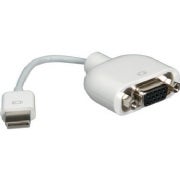 Use it for: Connecting small devices to DVI displays
Use it for: Connecting small devices to DVI displays
It's similar in performance and use to:DVI, HDMI
It adapts to: DVI, HDMI, Mini-DVI
Add more ports by: Connecting a switchbox
Even smaller than Mini-DVI, this port is most often found on tiny devices. A few Apple laptops have used it, although Apple has moved on to Mini DisplayPort.
DISPLAYPORT
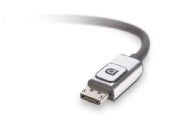 Use it for: Connecting recent computers and AV components to displays
Use it for: Connecting recent computers and AV components to displays
If you have a choice, select it instead of: VGA
It's similar in performance and use to: HDMI
It adapts to: DVI and VGA (pass-through signal); Mini-DisplayPort; HDMI
Add more ports by: Connecting a switchbox; upgrading your graphics card
Similar to HDMI, DisplayPort carries both digital audio and digital video signals. It isn't widely used, but several Apple computers and displays, PC graphics cards, and Dell monitors currently include the plug. DisplayPort also supports HDCP copy protection, as HDMI does.
MINI DISPLAYPORT
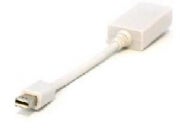 Use it for: Connecting small devices to displays
Use it for: Connecting small devices to displays
If you have a choice, select it instead of: VGA
It's similar in performance and use to: DisplayPort, HDMI
It adapts to: DVI and VGA (pass-through signal); DisplayPort; HDMI
A small version of DisplayPort, this connection is most often found on new Apple laptops.
AUDIO/VIDEO CABLE
HDMI, RCA, S-Video--sorting through the alphabet soup of audio/video cables can be difficult. Read on for everything you ever needed to know about plugging in your audio/video equipment for your home theater or for on-the-go jammin'.
HDMI (HIGH-DEFINITION MULTIMEDIA INTERFACE)
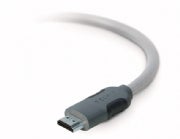 Use it for: Connecting Blu-ray players, TVs, AV receivers, PCs, game consoles, and other high-def video hardware
Use it for: Connecting Blu-ray players, TVs, AV receivers, PCs, game consoles, and other high-def video hardware
If you have a choice, select it instead of: Component video cables, analog audio cables
It's similar in performance and use to: DVI
It adapts to: DVI, Mini-DVI, Micro-DVI
Add more ports by: Connecting to a receiver
In addition to carrying pristine HD video at 1080p and beyond, HDMI can supply surround-sound audio, including Dolby Digital and DTS. This digital cable is your go-to cable for most home theater connections, including TVs, receivers, and game consoles. It supports HDCP encryption, so copy-protected movies should play without problems. This type of connection is available in several versions; HDMI 1.3 is typical, while 1.4 is rolling out now. The new version is capable of additional bandwidth for enabling high-resolution 3D video, and is part of the Blu-ray 3D specification.
RCA (AKA COMPOSITE VIDEO OR PHONO PLUG)
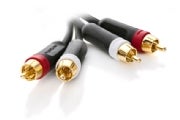 Use it for: Basic, analog audio and video; occasionally for digital audio
Use it for: Basic, analog audio and video; occasionally for digital audio
If you have a choice, select it instead of: Coaxial cable
It adapts to: Mini-jack ends (commonly found on camcorders and MP3 players)
Add more ports by: Connecting a splitter, repeater, or receiver
Introduced by RCA, this connector is ubiquitous among home audio and video components. Basic setups might use a white plug for mono audio--the left channel--and a yellow plug for video (not shown here). A red plug usually signifies right-channel audio, but the connector can carry other signals too. It's occasionally used for digital audio, in which one cable carries a full surround-sound signal. It's also the same kind of cable as for component video (see below).
COMPONENT VIDEO (AKA Y-PB-PR OR RGB)
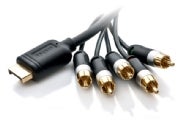 Use it for: HDTV video (especially older TVs), game systems
Use it for: HDTV video (especially older TVs), game systems
If you have a choice, select it instead of: Composite RCA video, S-Video
It's similar in performance and use to: VGA cables (especially the RGB version)
It adapts to: VGA, if your devices use the RGB version
Add more ports by: Connecting a splitter, repeater, or receiver
Component-video signals transmit over three RCA cables, typically coded red, green, and blue. Component video works at up to 1080i, making it a good option for analog HDTV connections. The cables typically run Y/Pb/Pr, which separates brightness, blue, and red to individual cables. Some systems use other signals, often RGB (red, green, blue); certain devices support both kinds of signals, but if you get a green-tinted image, you're probably set up for the wrong color space.
S-VIDEO (AKA Y/C)

Use it for: Midrange video devices
If you have a choice, select it instead of: RCA composite, coaxial
It's similar in performance and use to: Composite video
It adapts to: Composite video (but it loses its quality advantages)
Add more ports by: Connecting a splitter, repeater, or receiver
Though this kind of connection is a clear boost over a composite RCA connection, S-Video is still far from the quality of HDTV-supporting cables such as component.
COAXIAL VIDEO (AKA CABLE TV CONNECTION)
 Use it for: Connecting antennas; wiring a VCR to an analog TV; linking from the wall to the TV for cable broadcasts
Use it for: Connecting antennas; wiring a VCR to an analog TV; linking from the wall to the TV for cable broadcasts
It's similar in performance and use to: Composite video
Add more ports by: Connecting a splitter
The lowly coaxial cable supplies both analog audio and video between devices. It's also the cable of choice for TV-tuner antennas. Cable companies use this cable, although they'll typically send a digital signal that a converter box at your TV decodes. Nearly any time you attach a coaxial cable directly to a TV (except for a digital antenna), you should expect merely basic quality.
TOSLINK (AKA OPTICAL CABLE OR S/PDIF)
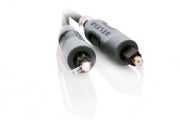 Use it for: Connecting DVD players, game systems, cable boxes, and other devices to audio receivers
Use it for: Connecting DVD players, game systems, cable boxes, and other devices to audio receivers
If you have a choice, select it instead of: Analog RCA audio; all other, common audio options
It's similar in performance and use to: Digital RCA audio over a single cable
It adapts to: Mini-Toslink
Add more ports by: Connecting a splitter or receiver
A digital connection, Toslink sends optical pulses that are decoded into audio. The commonly used S/PDIF signal carries surround details. ("S/PDIF" is sometimes used interchangeably as the cable name, although "Toslink" refers to the actual connector.) Mini-Toslink is occasionally used, especially with Apple computers; such jacks are often inside of the typical 3.5mm stereo mini-jack port.
MINI-JACK (AKA TRS, 3.5MM PLUG, 1/8-INCH PLUG, HEADPHONE JACK)
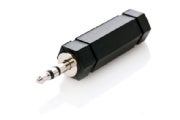 Use it for: Nearly every portable audio device, computers, portable speakers, video cameras
Use it for: Nearly every portable audio device, computers, portable speakers, video cameras
If you have a choice, select it instead of: A mono mini-jack
It's similar in performance and use to: 1/4-inch plug, 2.5mm plug
It adapts to: 1/4-inch plug, 2.5mm plug, RCA plugs
Add more ports by: Connecting a splitter
This headphone connector is ubiquitous, available on nearly every audio device and offered as the basic plug on media players. You'll most often encounter a stereo connection, which has two rings around the end. (If the plug has only one ring, it sends mono audio.) The plug is also often used to send video along with audio, adapting from the mini-jack end on a device to RCA plugs. The audio-signal output on a mini-jack is louder than the signal typically carried on stereo RCA plugs, so if you use an adapter (if you plug an iPod into a receiver, for example), turn up the volume slowly.
1/4-INCH PLUG (AKA TRS)
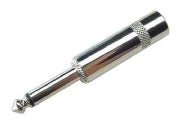 Use it for: Guitars and music equipment, home theater audio, pro equipment, headphones
Use it for: Guitars and music equipment, home theater audio, pro equipment, headphones
If you have a choice, select it instead of: A mono mini-jack
It's similar in performance and use to: Mini-jack, 2.5mm plug
It adapts to: Mini-jack, 2.5mm plug, RCA plugs
Add more ports by: Connecting a splitter
This connector most often carries stereo audio to headphones. You'll also find it on professional audio equipment, home theater audio components, and many headphone designs.
2.5MM PLUG (AKA TRS)
 Use it for: Mobile phone headsets
Use it for: Mobile phone headsets
It's similar in performance and use to: Mini-jack, 1/4-inch plug
It adapts to: Mini-jack, 1/4-inch plug, RCA plugs
Add more ports by: Connecting a splitter
Though some mobile phones include mini-jacks, many more interface with a 2.5mm plug, often supporting microphones or hold buttons. You can adapt your larger headphone cables to this small size in order to listen to music, however.
XLR
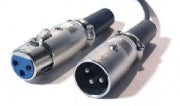 Use it for: Mostly midrange and high-end microphones
Use it for: Mostly midrange and high-end microphones
If you have a choice, select it instead of: 1/4-inch plug
It's similar in performance and use to: 1/4-inch plug
It adapts to: 1/4-inch plug (although in that case it doesn't power mics)
Add more ports by: Connecting to a mixer
While this kind of connector can support more pins, the three-pin version is used most often in midrange and professional audio hardware. Microphones typically use this cable, which also can provide them with power.
SPEAKER WIRE
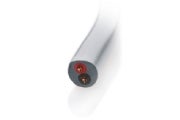 Use it for: Connecting speakers
Use it for: Connecting speakers
Add more ports by: Connecting a splitter or receiver
Strands of speaker wire--each with two cables inside--connect each speaker to your receiver. Brand-name versions are a waste of money. The gauge, however, can matter, especially when you're running long lengths, around 75 feet. Thicker wire (a lower gauge number) works best. Try not to use any excess cable, since that can produce interference. You can add a banana-plug tip to make the connection, but you'll get the same results by twisting the exposed wire end and inserting it into each device; just be sure to match the positive and negative markers on each component.
PERIPHERAL CABLE
From FireWire to Bluetooth, and from PATA to PS/2, we have information on all the plugs you need for your hard drives, cameras, phones, input devices, and other peripherals.
FIREWIRE 400 (AKA IEEE 1394, IEEE 1394A, OR I.LINK)
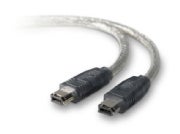 Use it for: Camcorders and external PC drives; also works (but is rarely used) for networking
Use it for: Camcorders and external PC drives; also works (but is rarely used) for networking
If you have a choice, select it instead of: USB 1.1 (for PC equipment); composite or S-Video cables (for video gear)
It's similar in performance and use to: USB 2.0 (for PC equipment)
It adapts to: Four- and six-pin styles; FireWire 800, with a physical adapter, will connect at FireWire 400 speeds
Add more ports by: Installing a PCI-card upgrade; connecting a hub; daisy-chaining devices
This audio/video and general PC serial connector comes in four- and six-pin variants. The four-pin FireWire option is most often found on camcorders and some laptops, while the six-pin version is usually on midlife Apple laptops, hard disks, and many desktop PCs. Some TVs, cable boxes, and other video gear use it. The six-pin style carries power, as USB does, so external hard drives often need no other cable. FireWire 400 runs at a theoretical speed up to 400 megabits per second.
FIREWIRE 800 (AKA IEEE 1394B)
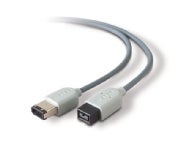 Use it for: Hard disks and other PC drives; also works (but is rarely used) for networking
Use it for: Hard disks and other PC drives; also works (but is rarely used) for networking
If you have a choice, select it instead of: FireWire 400 or any type of USB
It's similar in performance and use to: eSATA
It adapts to: FireWire 400 connectors (falling back to those speeds)
Add more ports by: Installing a PCI-card upgrade; connecting a hub; daisy-chaining devices
This general PC serial interface doubles the theoretical speed of the original FireWire while maintaining backward-compatibility (with an adapter); if you use it with old FireWire, the speed will be cut in half. You'll find this connection on Apple computers, and on many midrange and high-end PCs.
USB
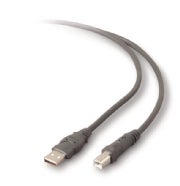 Use it for: Attaching basic, slow peripherals; charging gadgets
Use it for: Attaching basic, slow peripherals; charging gadgets
If you have a choice, select it instead of: PS/2 keyboard and mouse inputs
It's similar in performance and use to: PS/2 keyboard and mouse ports
It adapts to: Physical differences in more-recent USB styles
Add more ports by: Installing a PCI-card upgrade; connecting a hub
The classic, original USB is the bread-and-butter serial connector for linking input devices to a PC. In addition to mice and keyboards, you'll use it for printers, scanners, and other peripherals. One device, usually a PC, connects with the rectangular "A" end; the relatively square-shaped "B" end is often hard-wired, or connects to external devices. On this kind of connection, devices are hot-swappable, meaning that you can change them without restarting the PC. It also carries power and has become a ubiquitous charger plug for small gadgets.
USB 2.0
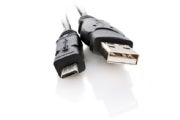 Use it for: External drives, cameras, mobile phones, other gadgets
Use it for: External drives, cameras, mobile phones, other gadgets
If you have a choice, select it instead of: USB 1.0
It's similar in performance and use to: FireWire 400, eSATA
It adapts to: Other USB shapes
Add more ports by: Installing a PCI-card upgrade; connecting a hub
Significantly faster than the original USB, the 2.0 version usually connects with an "A" end on a PC and a Mini-USB end on a peripheral. Some of the tiniest gadgets on the market opt to use the Micro-USB end. The faster bus of USB 2.0 means that it's much more suited to hard disks and to network adapters than the original version is.
SATA
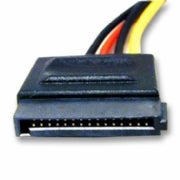 Use it for: Internal hard drives, Blu-ray and DVD burners, and other disks
Use it for: Internal hard drives, Blu-ray and DVD burners, and other disks
If you have a choice, select it instead of: ATA
It's similar in performance and use to: eSATA
It adapts to: eSATA
Add more ports by: Inserting an additional PCI controller card
Serial ATA connects internal disks within PCs. Many new computer case designs allow you to slide in a hard drive so that it meets directly with a port; otherwise, you'll use a cable. The fastest, most widely implemented version (often misnamed SATA II) runs at 3 gigabits per second and provides enough speed for the most disk-demanding tasks, such as high-end video capture.
ESATA
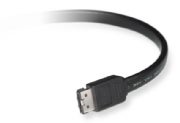
Use it for: External hard drives, Blu-ray and DVD-burners, and other disks; DVRs often support an eSATA drive for more storage space
If you have a choice, select it instead of: USB 1.0, FireWire 400
It's similar in performance and use to: USB 2.0, FireWire 800
It adapts to: SATA
Add more ports by: Inserting an additional PCI controller card
eSATA, a variant of SATA, simply takes that technology outside of a PC. eSATA is shielded from electrical interference and offers other considerations for making the move outside the case, and as a result is compatible with any kind of external disk.
ATA (AKA PARALLEL ATA OR PATA)
 Use it for: Internal floppy drives, CD-ROM drives, and other disks
Use it for: Internal floppy drives, CD-ROM drives, and other disks
Add more ports by: Inserting an additional PCI controller card (each ATA port can support two devices)
Still often used to connect internal floppy drives (should your PC even have one of those) and occasionally CD-ROM drives, ATA is the analog cousin of SATA. Because it is analog, it requires you to use certain cables and/or manually set jumper pins on connected devices.
PS/2
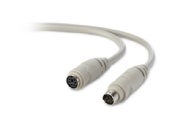 Use it for: Keyboards, mice, other input devices
Use it for: Keyboards, mice, other input devices
It's similar in performance and use to: USB 1.0
Add more ports by: Inserting an additional PCI controller card
This old, analog serial cable is still sometimes used to connect keyboards and mice. If you're troubleshooting a PC problem, connecting such input devices might be worthwhile, especially if you're having trouble interfacing with the BIOS. Otherwise, USB input devices are much more common and will likely work just as well.
BLUETOOTH
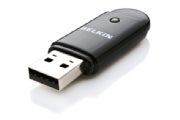 Use it for: Connecting PDAs, phones, GPS devices, digital cameras, earpieces, and other wireless audio gear; simple networking between PCs and/or gadgets; linking video game controllers
Use it for: Connecting PDAs, phones, GPS devices, digital cameras, earpieces, and other wireless audio gear; simple networking between PCs and/or gadgets; linking video game controllers
If you have a choice, select it instead of: USB (if wireless connectivity matters to you)
It's similar in performance and use to: USB
Add the functionality by: Installing an internal PC card or (more often) a USB-to-Bluetooth adapter dongle
Designed as a short-range, wireless connection for PCs and gadgets, Bluetooth can reach distances of 100 meters with certain hardware, but you'll most likely use it within a single room. The 2.1 version is currently the most widely used; it's backward-compatible with older Bluetooth devices, too. Bluetooth is a versatile connection and useful in many situations, although its modest speed of 3 megabits per second means that it won't replace other wireless tech. To connect devices, you "pair" them, putting each in a discoverable mode. You might also enter a password if both devices have a keyboard. (If only one does, consult your manual or try simple combinations such as '1234' or '0000'.)
NETWORKING CABLE
Whether your setup is wired or wireless, we have the cable know-how you need for your network.
CATEGORY 5E ETHERNET
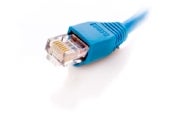 Use it for: Wired networks linking PCs, printers, and other devices
Use it for: Wired networks linking PCs, printers, and other devices
If you have a choice, select it instead of: Cat 5 and older standards; wired ethernet is still more reliable than Wi-Fi, too, especially when wireless mobility doesn't matter
It's similar in performance and use to: Wi-Fi (especially 802.11n)
It adapts to: Other ethernet versions
Add more ports by: Adding a switch or router to a network; installing an internal PC card on a computer
The latest, most widely used ethernet cable supports up to gigabit ethernet connections (as fast as the 10 Gigabit Ethernet standard), but you can use it on slower networks, too. (You're unlikely to own consumer hardware that exceeds gigabit speeds anyway.) Cat 5e cabling replaces Cat 5 and is slightly slower than Cat 6. Most ethernet cables use an 8P8C end, which looks similar to a phone plug but is slightly bigger and has more pins.
LEGACY WI-FI (AKA 802.11B, 802.11G, 802.11A)
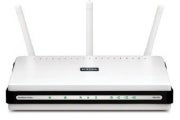 Use it for: Wireless-only networks (or bridging wireless networks to wired PCs), phones, PDAs, MP3 players, nearly all laptops
Use it for: Wireless-only networks (or bridging wireless networks to wired PCs), phones, PDAs, MP3 players, nearly all laptops
If you have a choice, select it instead of: Bluetooth, wired ethernet (when mobility is more valuable than speed)
It's similar in performance and use to: Wired ethernet
It adapts to: Other Wi-Fi variants
Add more connections by: Installing a wireless PC card or router (PC cards will talk to one other device or network at a time, while routers can network dozens)
Though 802.11n maintains compatibility with older wireless standards, in such a setup the network must operate at the slower, older speeds for all connected devices. ("Dual-band" routers can isolate the old gear on its own wireless radio so that you don't have this drawback.) 802.11b is noticeably slower when transferring local files, while the other variants of Wi-Fi approach speeds similar to those of wired ethernet.
802.11N WI-FI
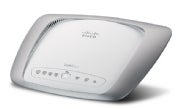 Use it for: Wireless-only networks (or bridging wireless networks to wired PCs), phones, PDAs, MP3 players, nearly all laptops
Use it for: Wireless-only networks (or bridging wireless networks to wired PCs), phones, PDAs, MP3 players, nearly all laptops
If you have a choice, select it instead of: Legacy Wi-Fi, wired ethernet (when mobility is more valuable than speed)
It's similar in performance and use to: Wired ethernet
It adapts to: Other Wi-Fi variants
Add more connections by: Installing a wireless PC card or router (PC cards will talk to one other device or network at a time, while routers can network dozens)
Though the actual 802.11n standard is still being finalized, compatible hardware is already common. Theoretically, once the standard is complete, you'll be able to update draft-standard equipment through firmware. 802.11n improves in speed and general performance over legacy Wi-Fi standards.
PROPRIETARY CABLE
Have a cable you don't recognize? Here's our guide to various proprietary, device-specific cables commonly used for game consoles and portable gadgets.
IPOD CONNECTOR
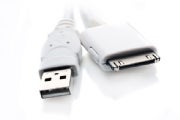 Use it for: Connecting an iPod to anything
Use it for: Connecting an iPod to anything
If you have a choice, select it instead of: The headphone-out port
It's similar in performance and use to: The headphone-out port (depending on its use)
It adapts to: USB, S-Video, component video, Toslink audio, RCA audio, and more
Apple has standardized its connector across different iPod models thus far, although the plug is still used only on iPods. Depending on the cable or device attached, this connector can result in USB, audio, video, and other ports.
ZUNE CONNECTOR
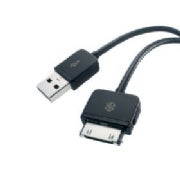 Use it for: Connecting a Zune to anything
Use it for: Connecting a Zune to anything
If you have a choice, select it instead of: The headphone-out port
It's similar in performance and use to: The headphone-out port (depending on the situation)
It adapts to: USB, S-Video, component video, Toslink audio, RCA audio, and more
Similar to the situation with iPods, Microsoft has standardized its connector across different versions of its Zune player, but you won't find this plug on anything aside from Zunes. Depending on the cable or device attached, this connector can result in USB, audio, video, and other ports.
XBOX 360, PLAYSTATION 3, OR WII CONNECTOR
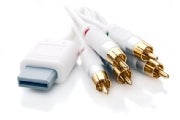 Use it for: Connecting a game console to a TV and audio system
Use it for: Connecting a game console to a TV and audio system
It adapts to: S-Video, composite video, component video, RCA audio, VGA, and more
Video game consoles from Microsoft, Sony, and Nintendo (cables pictured here) all have proprietary jacks, though the Sony PlayStation 3 also uses standard HDMI. This setup allows the systems to send signals out to a variety of plugs, including component video, composite video, RCA audio, and S-Video.
No comments:
Post a Comment